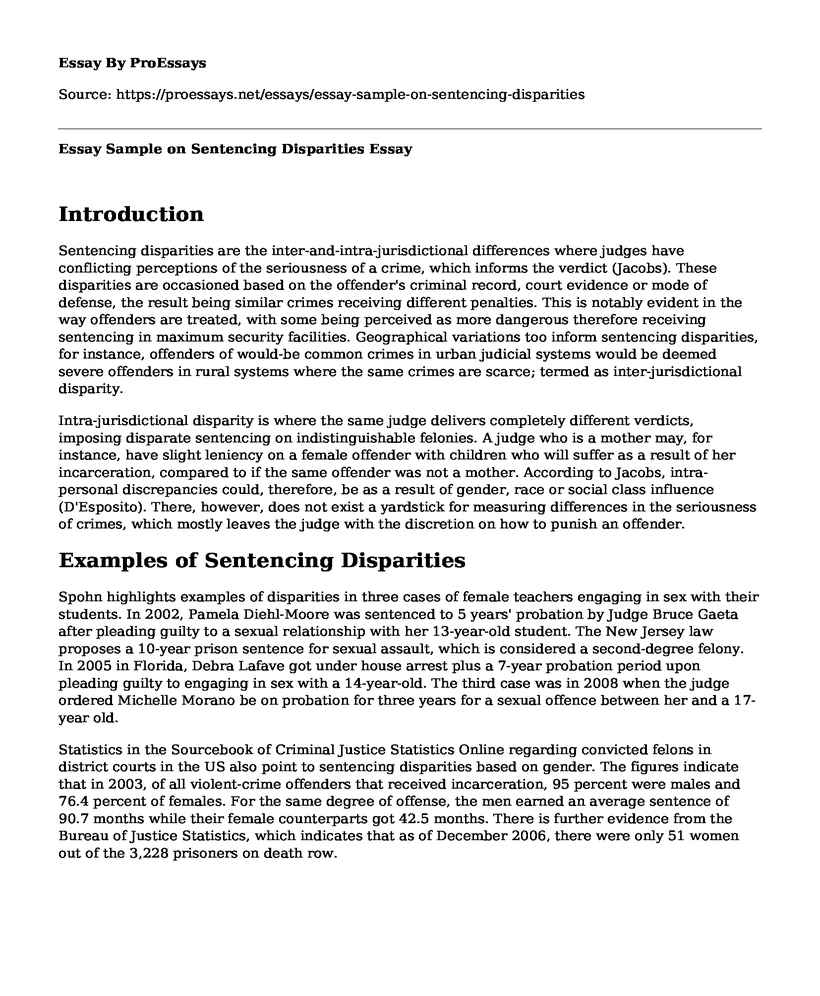Introduction
Sentencing disparities are the inter-and-intra-jurisdictional differences where judges have conflicting perceptions of the seriousness of a crime, which informs the verdict (Jacobs). These disparities are occasioned based on the offender's criminal record, court evidence or mode of defense, the result being similar crimes receiving different penalties. This is notably evident in the way offenders are treated, with some being perceived as more dangerous therefore receiving sentencing in maximum security facilities. Geographical variations too inform sentencing disparities, for instance, offenders of would-be common crimes in urban judicial systems would be deemed severe offenders in rural systems where the same crimes are scarce; termed as inter-jurisdictional disparity.
Intra-jurisdictional disparity is where the same judge delivers completely different verdicts, imposing disparate sentencing on indistinguishable felonies. A judge who is a mother may, for instance, have slight leniency on a female offender with children who will suffer as a result of her incarceration, compared to if the same offender was not a mother. According to Jacobs, intra-personal discrepancies could, therefore, be as a result of gender, race or social class influence (D'Esposito). There, however, does not exist a yardstick for measuring differences in the seriousness of crimes, which mostly leaves the judge with the discretion on how to punish an offender.
Examples of Sentencing Disparities
Spohn highlights examples of disparities in three cases of female teachers engaging in sex with their students. In 2002, Pamela Diehl-Moore was sentenced to 5 years' probation by Judge Bruce Gaeta after pleading guilty to a sexual relationship with her 13-year-old student. The New Jersey law proposes a 10-year prison sentence for sexual assault, which is considered a second-degree felony. In 2005 in Florida, Debra Lafave got under house arrest plus a 7-year probation period upon pleading guilty to engaging in sex with a 14-year-old. The third case was in 2008 when the judge ordered Michelle Morano be on probation for three years for a sexual offence between her and a 17-year old.
Statistics in the Sourcebook of Criminal Justice Statistics Online regarding convicted felons in district courts in the US also point to sentencing disparities based on gender. The figures indicate that in 2003, of all violent-crime offenders that received incarceration, 95 percent were males and 76.4 percent of females. For the same degree of offense, the men earned an average sentence of 90.7 months while their female counterparts got 42.5 months. There is further evidence from the Bureau of Justice Statistics, which indicates that as of December 2006, there were only 51 women out of the 3,228 prisoners on death row.
Impacts of Sentencing Disparities
D'Esposito cites the first flipside of sentencing disparities as antagonism towards not only the justice system but society as a whole. That when an offender receives a penalty that he or she finds harsher than the felony, the individual's discipline and perception towards rehabilitation is impaired. The same feelings could also be witnessed in members of the offender's family, who lose confidence in the legal system.
Away from the felon, sentencing disparities negatively affect the justice system as they contradict the concept of fair and equal treatment as stated in the US Constitution's Fifth and Fourteenth Amendments. According to the amendment, treatment should be rational and factual, devoid of unreasonable and arbitrary distinctions to accord legitimacy to the purpose. It goes further to put a limit on the amount of power that state officials can wield when treating employees, colleagues and members of the general public, regardless of religion, race or gender.
Works Cited
Bureau of Justice Statistics. (BJS) - Key Statistics". Bjs.Gov, 2007, https://www.bjs.gov/index.cfm?ty=kfa. Accessed 18 Aug 2018.
D'Esposito, Julian C. "Sentencing Disparity: Causes and Cures." The Journal of Criminal Law, Criminology, And Police Science, vol 60, no. 2, 1969, p. 182. JSTOR, doi:10.2307/1142238.
Jacobs, Danielle. "Sentencing: Disparity - Types of Disparity." Law.Jrank.org, 2014, http://law.jrank.org/pages/2050/Sentencing-Disparity-Types-disparity.html. Accessed 18 Aug 2018.
Sourcebook of Criminal Justice Statistics. Albany.Edu, 2003", https://www.albany.edu/sourcebook/. Accessed 18 Aug 2018.
Spohn, Cassia. "Sentencing Disparity and Discrimination: Gender." Uk.Sagepub.com, https://uk.sagepub.com/sites/default/files/upm-binaries/27008_4.pdf. Accessed 18 Aug 2018.
US Constitution - 5Th and 14Th Amendments | Finduslaw". Finduslaw.Com, 2018, https://finduslaw.com/us-constitution-5th-14th-amendments. Accessed 18 Aug 2018.
Cite this page
Essay Sample on Sentencing Disparities. (2022, Jul 11). Retrieved from https://proessays.net/essays/essay-sample-on-sentencing-disparities
If you are the original author of this essay and no longer wish to have it published on the ProEssays website, please click below to request its removal:
- Mobile Phone Forensics - Example of Writing Assignment
- Essay Sample on Theories of Juvenile Crime
- Title IX Debate: The Issue of the Inclusion of College Football
- Application for Full Prescriptive Authority
- Essay Sample on Mexican Cartels
- Research Paper on Paul Bernardo: Canadian Serial Killer
- Essay Sample on The Central Park Five: The Tragic 1989 Incident That Changed Everything







